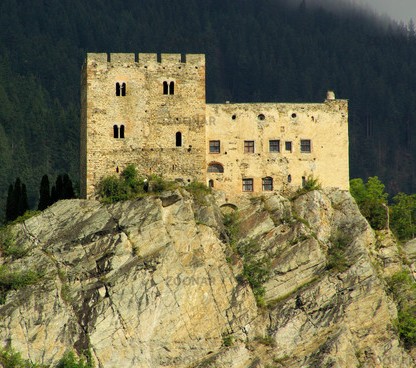

Location: Tyrol Map
Burg Laudegg, also known as Laudegg Castle or Laudeck Castle, is a restored medieval castle ruin located on a rock spur at an elevation of 1,176 meters (3,858 ft) above the Oberinntal valley in the village of Ladis, within the Serfaus-Fiss-Ladis holiday region of Tyrol, Austria. Perched at the foot of the Samnaun Alps along an ancient Roman road, it overlooks the scenic Upper Inn Valley and serves as a prominent landmark in the Bezirk Landeck district. Originally built as a guard tower and administrative stronghold, the castle exemplifies Tyrolean medieval architecture and reflects the region's feudal history. Today, it is privately owned and partially integrated with modern hospitality through the adjacent Refugio Laudegg hotel, blending historical preservation with contemporary tourism in one of Austria's premier alpine destinations.
The history of Burg Laudegg dates to the early Middle Ages, with
archaeological evidence suggesting origins as a Roman guarding tower
along an ancient trade route. The residential tower was constructed
around 1200 AD, and the castle was first documented in 1239 as part of
the Court of Duke Otto von Andechs, with an earlier reference to a
ministerial family of "Laudeck" in 1232. It functioned as the
administrative center for the Laudeck High Court (Oberes Gericht),
overseeing the Upper Inn Valley until the 17th century.
A pivotal
event occurred in 1406 during the Appenzell peasant uprising
(Appenzeller Farmer Rebellion) led by Itel Reding, when the castle,
along with the town of Ladis and the nearby Steinegg Castle (its
barbican), was burned and destroyed. Minimal repairs followed, and under
Emperor Maximilian I, some expansions were attempted, though promised
funds were not delivered, limiting the rebuild. By 1551, it was no
longer used as a primary residence or weapons store, with the keeper
relocating to Schloss Siegmundsried. In the 16th century, it
transitioned to roles as a prison and arms depot, gradually
deteriorating after the administrative seat moved to Ried im Oberinntal
in the 17th century. Ownership shifted over time, eventually becoming
private property. Partial restoration efforts began in 1964, stabilizing
the structure and allowing public access.
Burg Laudegg is classified as a tower house (Wohnturm), built
primarily from slate on a vertical rock protrusion, leveraging its
elevated position for defensive and strategic advantages over the
valley. The architecture is relatively simple, characteristic of early
medieval Tyrolean fortifications, with a prominent 13th-century
residential tower as the core feature. Additional elements include a
residential wing, an outer ward (Vorburg), a dungeon, and remnants of
defensive walls. The structure's layout reflects its origins as a guard
tower, with later additions from rebuilds after 1406.
The castle's
setting enhances its visual appeal: enthroned above Ladis, it offers
panoramic views of the surrounding mountains and valley, with a nearby
castle lake (actually a small pond) adding to the scenic charm. Adjacent
modern developments, such as the Refugio Laudegg hotel, incorporate
regional materials like wood and stone in a fragmented, terraced design
that echoes the castle's stables—featuring solid white-plastered ground
floors and timber upper levels—to harmonize with the historic site.
Burg Laudegg is a well-preserved ruin, having undergone partial
restoration since 1964 to prevent further decay. It remains privately
owned by the family of Prof. Apel and is protected as a historical
monument. While the castle itself is not inhabited, limited areas—such
as the kitchen, chapel, and staircase—are accessible during guided
tours. Proceeds from visits support cultural preservation. No guided
tours are scheduled for 2025, though this may change; historically, it
has been open once a week in summer.
The site integrates with modern
tourism through the Refugio Laudegg, a boutique hotel offering 4 themed
suites and 9 double rooms, designed in collaboration with heritage
authorities. This facility emphasizes Tyrolean tradition with
contemporary amenities like saunas, gardens, and a restaurant serving
local cuisine, including vegetarian options and game dishes. It caters
to active travelers, supporting activities such as skiing, hiking, and
cycling in the Serfaus-Fiss-Ladis region.
Burg Laudegg holds a 3.9 out of 5 rating on Tripadvisor based on 15
reviews, with visitors appreciating its fantastic panoramic views,
informative guided tours on the history of Ladis and the castle, and
family-friendly atmosphere—even on rainy days. However, criticisms
include limited accessibility (only a few rooms open, as parts are
inhabited), closure most days (historically only Wednesdays), no
parking, and mismatched online photos (e.g., the "lake" is a small
pond). Some describe it as disappointing for casual visits without
tours.
The castle is open to the public only during July and August,
typically on Wednesdays for guided tours (adult tickets around 2 Euros),
though no tours are planned for 2025—check official sources for updates.
Access involves a short walk or hike to the site, suitable for families
but requiring sturdy shoes due to the terrain. For the Refugio Laudegg
hotel, bookings can be made via laudegg.at, with amenities including
free parking, pet-friendly rooms, and guided hikes by staff. Combine
visits with nearby attractions like Berneck Castle, the
Serfaus-Fiss-Ladis ski area, or local trails for a full experience.
Photography is encouraged for the stunning alpine vistas, and the site
is ideal for those seeking a blend of history and relaxation.